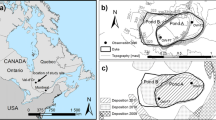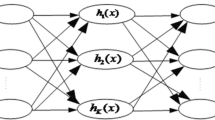Abstract
The proper design, development, and appropriate tuning of the Hybrid Neural Network architecture, mainly for its parsimoniousity and optimal training can help practitioners to generate a robust predictive tool for modeling several important hydrological processes within the water resources sector. In this paper, the Feedforward Artificial Neural Network (FFANN) and the hybrid WANN model have been developed, and later, coupled with the Gamma and M-tests (GT) approach for forecasting spatio-temporal groundwater fluctuations in a complex alluvial aquifer system. The performance of these hybrid models were evaluated using goodness-of-fit criteria. An analysis of the modeling results indicates that the GT coupled with the WANN model was able to provide significantly improved results, with lower values of the root mean square error (RMSE) and higher values of the NSE metric for the 1-week and 3-week lead times. Hence, utilizing this hybrid model, the groundwater level prediction tests were extended for 6-week and 12-week lead times with the GT approach, coupled with the WANN hybrid model only. The results showed that the accuracy of the GT-WANN hybrid model was better for the unconfined aquifer system compared to the leaky confined aquifer system. Furthermore, the present study also examined the interdependence between different model inputs and output variables for the selected study sites by means of the Wavelet Coherent Analysis (WCA). These results indicated that all the model’s input variables have a significant effect on the groundwater level of unconfined aquifers, and confirmed the nature of the aquifers tapped within the present study sites. The study finally concludes that the GT-WANN approach can be a robust predictive tool for modeling spatio-temporal fluctuations of groundwater levels.








Similar content being viewed by others
References
Anderson D, McNeill G (1992) Artificial neural networks technology. A DACS state-of-the-art report. Kaman Sciences Corporation, New York, p 87
Aziz ARA, Wong KFV (1992) Neural network approach to the determination of aquifer parameters. Ground Water 30(2):164–166
Balkhair KS (2002) Aquifer parameters determination for large diameter wells using neural network approach. J Hydrol 265(1):118–128
Chai T, Draxler RR (2014) Root mean square error (RMSE) or mean absolute error (MAE)?–arguments against avoiding RMSE in the literature. Geosci Model Dev 7:1247–1250
Chang C, Glover GH (2010) Time frequency dynamics of resting state brain connectivity measured with MRI. Neuro Image 50(1):81–98
Coppola EA, Szidarovszky F, Poulton MM, Charles E (2003) Artificial neural network approach for predicting transient water levels in a multilayered groundwater system under variable state, pumping, and climate conditions. J Hydrol Eng ASCE 8(6):348–360
Coulibaly P, Anctil F, Aravena R, Bobee B (2001) Artificial neural network modeling of water table depth fluctuations. Water Resour Res 37(4):885–896
Daliakopoulos IN, Coulibaly P, Tsanis IK (2005) Groundwater level forecasting using artificial neural networks. J Hydrol 309(1–4):229–240
Durrant, P. J. (2001). winGammatm: a non-linear data analysis and modelling tool with applications to flood prediction. PhD thesis, Department of Computer Science, Cardi® University, UK
Evans D, Jones AJ (2002a) Asymptotic moments of near neighbour distance distributions. Proc Roy Soc Lond, Seri A 458(2028):2839–2849
Evans D, Jones AJ (2002b) A proof of the gamma test. Proc Roy Soc Lond, Ser A 458(2027):2759–2799
Gallant SI (1993) Neural network learning and expert systems. The MIT Press, Massachusetts
Grinsted A, Moore JC, Jevrejeva S (2004) Application of the cross wavelet transform and wavelet coherence to geophysical time series. Nonlinear Process Geophys 11(5/6):561–566
Haykin S (2004) Neural networks: a Comprehensive Foundation. Prentice Hall, New Jersey 837 pp
Hong YS, Rosen MR (2001) Intelligent characterization and diagnosis of the groundwater quality in an urban fractured-rock aquifer using an artificial neural network. Urban Water 3(3):193–204
Jha MK, Chikamori K, Kamii Y, Yamasaki Y (1999) Field investigations for sustainable groundwater utilization in the Konan basin. Water Resour Manag 13:443–470
Jha MK, Kamii Y, Chikamori K (2002) Sustainable groundwater management in Kochi plain: 1. Analysis of groundwater quantity. Res Rep Kochi Univ, Natural Sci, Japan 51:23–51
Kemp SE, Wilson ID, Ware JA (2004) A tutorial on the gamma test. Int J Simul 6:67–75
Kisi O (2009) Modeling monthly evaporation using two different neural computing techniques. Irrig Sci 27:417–430
Krishna B, Satyaji Rao YR, Vijaya T (2008) Modeling groundwater levels in an urban coastal aquifer using artificial neural networks. Hydrol Process 22(8):1180–1188
Kuo V, Liu C, Lin K (2004) Evaluation of the ability of an artificial neural network model to assess the variation of groundwater quality in an area of Blackfoot disease in Taiwan. Water Res 38(1):148–158
Lin G, Chen G (2005) An improved neural network approach to the determination of aquifer parameter. J Hydrol 20:1–9
Maier HR, Dandy GC (2000) Neural networks for the prediction and forecasting of water resources variables: a review of modeling issues and applications. Environ Model Software 15:101–124
Milot J, Rodriguez MJ, Serodes JB (2002) Contribution of neural networks for modeling trihalomethanes occurrence in drinking water. J Water Resour Plann Manag, ASCE 128(5):370–376
Morshed J, Kaluarachchi JJ (1998) Parameter estimation using artificial neural network and genetic algorithm for free-product migration and recovery. Water Resour Res 34(5):1101–1113
Nash J, Sutcliffe J (1970) River flow forecasting through conceptual models part I—A discussion of principles. J Hydrol 10:282–290
Nayak PC, Rao VRS, Sudheer KP (2006) Groundwater level forecasting in shallow aquifer using artificial neural network approach. Water Resour Manag 20:77–90
Nourani V, Mousavi S (2016) Spatiotemporal groundwater level modeling using hybrid artificial intelligence meshless method. J Hydrol 536:10–25
Nourani V, Mogaddam AA, Nadiri AO (2008) An ANN-based model for spatiotemporal groundwater level forecasting. Hydrol Process 22(26):5054–5066
Remesan R, Shamim MA, Han D (2008) Model data selection using gamma test for daily solar radiation estimation. Hydrol Process 22(21):4301–4309
Remesan R, Shamin MA, Han D, Mathew J (2009) Runoff prediction using an integrated hybrid modelling scheme. J Hydrol 372:48–60
Rogers LL, Dowla FU (1994) Optimization of groundwater remediation using artificial neural networks with parallel solute transport modeling. Water Resour Res 30(2):457–481
Sahoo S, Jha MK (2013) Groundwater-level prediction using multiple linear regression and artificial neural network techniques: a comparative assessment. Hydrogeol J 21(8):1865–1887
Shoaib M, Shamseldin A, Melville B, Khan M (2016) Hybrid wavelet neuro-fuzzy approach for rainfall-runoff modeling. J Comput Civil Eng, ASCE 30(1). https://doi.org/10.1061/(ASCE)CP.1943-5487.0000457
Singh KP, Basant A, Malik A, Jain G (2009) Artificial neural network modeling of the river water quality: a case study. Ecol Model 220:888–895
Stefansson A, Koncar N, Jones AJ (1997) A note on the gamma test. Neural Comput Appl 5(3):131–133
Tangborn A (2004) Wavelet approximation of error covariance propagation in data assimilation. Tellus 56(1):16–28
Zhou HC, Peng Y, Liang GH (2008) The research of monthly discharge predictor-corrector model based on wavelet decomposition. Water Resour Manag 22:217–227
Acknowledgements
The authors are grateful to the Government agencies for providing data required for conducting this study.
Author information
Authors and Affiliations
Corresponding author
Ethics declarations
Conflict of Interest
The authors also confirm that the content of this article has no conflicts of interest.
Additional information
Publisher’s Note
Springer Nature remains neutral with regard to jurisdictional claims in published maps and institutional affiliations.
Rights and permissions
About this article
Cite this article
Roshni, T., Jha, M.K., Deo, R.C. et al. Development and Evaluation of Hybrid Artificial Neural Network Architectures for Modeling Spatio-Temporal Groundwater Fluctuations in a Complex Aquifer System. Water Resour Manage 33, 2381–2397 (2019). https://doi.org/10.1007/s11269-019-02253-4
Received:
Accepted:
Published:
Issue Date:
DOI: https://doi.org/10.1007/s11269-019-02253-4




